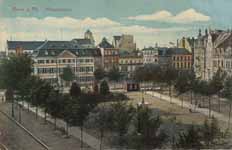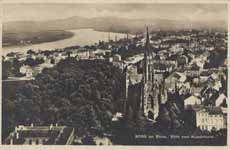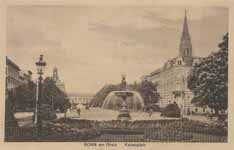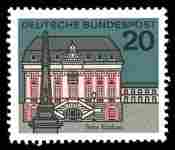.






Bonn

Bonn,
Bonn, Paintings, Drawings, Illustrations
Bonn is the 19th largest city in Germany. Located in the Cologne/Bonn Region, about 25 kilometres south of Cologne on the river Rhine in the State of North Rhine-Westphalia, it was the capital of West Germany from 1949 to 1990 and the official seat of government of united Germany from 1990 to 1999. Starting in 1998, many national government institutions were moved from Bonn to Berlin. Both houses of the German national parliament, the Bundestag and the Bundesrat, were moved along with the Chancellery and the residence of the President of Germany.
Bonn remains a centre of politics and administration, however. Roughly half of all government jobs were retained as many government departments remained in Bonn and numerous sub-ministerial level government agencies relocated to the former capital from Berlin and other parts of Germany. In recognition of this, the former capital now holds the title of Federal City ("Bundesstadt").
Bonn has developed into a hub of international cooperation in particular in the area of environment and sustainable development. In addition to a number of other international organizations and institutions, such as, for instance, the IUCN Environmental Law Center (IUCN ELC) the City currently hosts 17 United Nations institutions. Among these are two of the so-called Rio Conventions, the United Nations Framework Convention on Climate Change (UNFCCC) and the United Nations Convention to Combat Desertification (UNCCD). The number of UN agencies in Bonn, most of which are based at the newly established United Nations Campus in the city's former parliamentary quarter on the banks of the Rhine, continues to grow. The most recent agency was started in 2007 in Bonn as the United Nations Platform for Space-based Information for Disaster Management and Emergency Response (UN-SPIDER).
Bonn is the seat of some of Germany's largest corporate players, chiefly in the areas of telecommunications and logistics. Simultaneously, Bonn is establishing itself as an important national and international centre of meetings, conventions and conferences, many of which are directly related to the work of the United Nations. A new conference centre capable of hosting thousands of participants is currently under construction in the immediate vicinity of the UN Campus.
From 1597 to 1794, it was the residence of the Archbishops and Prince-electors of Cologne, and is the birthplace of Ludwig van Beethoven (born 1770).
History
Langer Eugen, centre of the United Nations Campus
Sterntor (star gate), a reconstruction of a gate of the medieval city wall
Historic Town Hall of Bonn (view from the market square)
The history of the city dates back to Roman times. In about 11 BC, the Roman Army appears to have stationed a small unit in what is presently the historical centre of the town. Even earlier, the Army had resettled members of a Germanic tribal group allied with Rome, the Ubii, in Bonn. The Latin name for that settlement, "Bonna", may stem from the original population of this and many other settlements in the area, the Eburoni. The Eburoni were members of a large tribal coalition effectively wiped out during the final phase of Caesar's War in Gaul. After several decades, the Army gave up the small camp linked to the Ubii-settlement. During the 1st century AD, the Army then chose a site to the north of the emerging town in what is now the section of Bonn-Castell to build a large military installation dubbed Castra Bonnensis, i.e., literally, "Fort Bonn". Initially built from wood, the fort was eventually rebuilt in stone. With additions, changes and new construction, the fort remained in use by the Army into the waning days of the Western Roman Empire, possibly the mid-5th century. The structures themselves remained standing well into the Middle Ages, when they were called the Bonnburg. They were used by Frankish kings until they fell in disuse. Eventually, much of the building materials seem to have been re-used in the construction of Bonn's 13th century city wall. The Sterntor (star gate) in the town centre is a reconstruction using the last remnants of the medieval city wall.
To date, Bonn's Roman fort remains the largest fort of its type known from the ancient world, i.e. a fort built for one full-size Imperial Legion and its auxiliaries. The fort covered an area of approximately 250,000 square metres (62 acres). Between its walls it contained a dense grid of streets and a multitude of buildings, ranging from spacious headquarters and large officers' houses to barracks, stables and a military jail. Among the legions stationed in Bonn, the "1st", i.e. the Prima Legio Minervia, seems to have served here the longest. Units of the Bonn legion were deployed to theatres of war ranging from modern-day Algeria to what is now the Russian republic of Chechnya.
The chief Roman road linking the provincial capitals of Cologne and Mainz cut right through the fort where it joined the fort's main road (now, Römerstraße). Once past the South Gate, the Cologne-Mainz road continued along what are now streets named Belderberg, Adenauerallee et al. On both sides of the road, the local settlement, Bonna, grew into a sizeable Roman town.
In late antiquity, much of the town seems to have been destroyed by marauding invaders. The remaining civilian population then holed up inside the fort along with the remnants of the troops stationed here. During the final decades of imperial rule, the troops were supplied by Germanic chieftains employed by the Roman administration. When the end came, these troops simply shifted their allegiances to the new barbarian rulers. From the fort, the Bonnburg, as well as from a new medieval settlement to the South centred around what later became the minster, grew the medieval city of Bonn.
Between the 11th and 13th centuries, the Romanesque style Bonn Minster was built, and in 1597 Bonn became the seat of the Archdiocese of Cologne. The town gained more influence and grew considerably. The elector Clemens August (ruled 1723-1761) ordered the construction of a series of Baroque buildings which still give the city its character. Another memorable ruler was Max Franz (ruled 1784-1794), who founded the university and the spa quarter of Bad Godesberg. In addition he was a patron of the young Ludwig van Beethoven, who was born in Bonn in 1770; the elector financed the composer's first journey to Vienna.
In 1794, the town was seized by French troops, becoming a part of the First French Empire. In 1815 following the Napoleonic Wars, Bonn became part of the Kingdom of Prussia. Administered within the Prussian Rhine Province, the town became part of the German Empire in 1871 during the Prussian-led unification of Germany. Bonn was of little relevance in these years.
Modern history
During World War II, Bonn acquired military significance because of its strategic location on the Rhine River, which formed a natural barrier to easy penetration into the German heartland from the west. The Allied ground advance into Germany reached Bonn on 7 March 1945, and the US 1st Infantry Division captured the city during the battle of 8-9 March 1945.[2]
Following World War II, Bonn was in the British zone of occupation, and in 1949 became the provisional capital of West Germany. The choice of Bonn was made mainly due to the advocacy of West Germany's first chancellor, Konrad Adenauer, a former Cologne Mayor and a native of that area. This was despite the fact that Frankfurt already had most of the required facilities and using Bonn was estimated to be 95 million DM more expensive than using Frankfurt. It was thought, however, that locating the capital in a major city like Frankfurt or Hamburg would imply a permanent capital.
Because of its relatively small size for a capital city, Bonn was sometimes referred to, jokingly, as the Bundeshauptstadt ohne nennenswertes Nachtleben (Federal capital without noteworthy night-life) or the Bundesdorf (Federal Village).[3] At one point in the post-WWll/Cold War era, the U.S. Embassy in Bonn was America's largest, "comparable, with its thousands of staff, to the [U.S.] Baghdad embassy today."[4]
German reunification in 1990 made Berlin the nominal capital of Germany again. This decision did not mandate that the republic's political institutions would also move. While some argued for the seat of government to move to Berlin, others advocated leaving it in Bonn--a situation roughly analogous to that of the Netherlands, where Amsterdam is the capital but The Hague is the seat of government. Berlin's previous history as united Germany's capital was strongly connected with Imperial Germany, and more ominously with Nazi Germany. It was felt that a new peacefully united Germany should not be governed from a city connected to such overtones of war. Additionally, Bonn was closer to Brussels, headquarters of the EU.
The heated debate that resulted was settled by the Bundestag (Germany's parliament) only on 20 June 1991. By a vote of 338-320[5], the Bundestag voted to move the seat of government to Berlin. The vote broke largely along generational lines, with younger legislators favouring Bonn and older legislators who remembered Berlin's past voting for Berlin. In the end, the 25 members from the two then-tiny Ossi parties tipped the margin in favour of Berlin.
While the government and parliament moved to Berlin, as a compromise, some of the ministries (such as Defence and Agriculture) largely remained in Bonn, with only the top officials in Berlin. There was no plan to move these departments, and so Bonn remained a second, unofficial capital with the new title "Federal City" (Bundesstadt). Because of the necessary construction work, the move took until 1999 to complete.
At present, the private sector plays a major role in Bonn's economy. With 5 stock listed companies, Bonn has the 4th highest market capitalisation amongst German towns. With headquarters of DHL, T-Mobile and other renowned companies, managers have replaced the public sector.
View over central Bonn
Main sights
Godesburg Fortress.
Hofgarten (Court Garden) with Kurfürstliches Schloss (Electoral Prince's Castle), which serves as the main building of the University of Bonn. The church steeple of the Bonn Minster can be seen in the background.
Post Tower, headquarters of Deutsche Post/DHL.
Langer Eugen, centre of the UN Campus at the River Rhine in Bonn (view from the Post Tower).
Beethoven's birth place is located in Bonngasse near the market place. Next to the market place is the Old Town Hall, built in 1737 in Rococo style, under the rule of Clemens August of Bavaria. It is used for receptions of guests of the town, and as an office for the mayor. Nearby is the Kurfürstliches Schloss, built as a residence for the prince-elector and now the main building of the University of Bonn.
The Poppelsdorfer Allee is an alley flanked by chestnut trees which had the first horsecar of the town. It connects the Kurfürstliches Schloss with the Poppelsdorfer Schloss, a palace that was built as a resort for the prince-electors in the first half of the 18th century, and whose grounds are now a botanical garden (the Botanischer Garten Bonn). This axis is interrupted by a railway line and Bonn Hauptbahnhof, a building erected in 1883/84.
The Beethoven Monument stands on the Münsterplatz, which is flanked by the Bonn Minster, one of Germany's oldest churches.
The three highest buildings in the city are the radio mast of WDR in Bonn-Venusberg (180 m), the headquarters of the Deutsche Post called Post Tower (162.5 m) and the former building for the German members of parliament Langer Eugen (114.7 m) now the new location of the UN-Campus.
Churches
Bonn Minster[6]
Doppelkirche (Double Church) Schwarzrheindorf built in 1151[7]
Old Cemetery Bonn, one of the best known ones in Germany[8]
Kreuzbergkirche built in 1627 with Johann Balthasar Neumann's Heilige Stiege, a stairway for Christian pilgrims[9]
Castles and residences
Godesburg fortress ruins[10][11]
Modern buildings
Beethovenhalle
Beethoven's Pianos in the Beethoven-Haus. Stieler's famous portrait hangs on the wall.
Beethovenhalle
Bundesviertel (federal quarter) with lots of government structures including
Post Tower, the tallest building in the state North Rhine-Westphalia, housing the headquarters of Deutsche Post/DHL
Maritim Bonn, 5 star hotel and convention centre
Schürmann-Bau, headquarters of Deutsche Welle
Langer Eugen, since 2006 the centre of the United Nations Campus, formerly housing the offices of the members of the German parliament
Deutsche Telekom headquarters
T-Mobile headquarters
Kameha Grand, 5 star hotel
Museums
Museum Mile with
Kunst- und Ausstellungshalle der Bundesrepublik Deutschland (Art and Exhibition Hall of the Federal Republic of Germany) showing the Guggenheim Collection in 2006-2007[12]
Kunstmuseum Bonn (Bonn Museum of Modern Art)[13]
Haus der Geschichte (Museum of the History of the Federal Republic of Germany)[14]
Museum Koenig where the Parlamentarischer Rat first met[15]
Beethoven House, birthplace of Ludwig van Beethoven[16]
Rheinisches Landesmuseum Bonn (Rhinish Regional Museum Bonn)[17]
Bonn Women's Museum
August-Macke-Haus (museum dedicated to Expressionist painter August Macke)
Arithmeum
Nature
Arboretum Park Härle, an arboretum with specimens dating to 1870
Botanischer Garten (Botanical Garden), where Titan arum set a world record[18]
Rheinaue (Bonn), a leisure park on the banks of the Rhine[19]
Kottenforst, a large area of protected woods on the hills west of the city centre[20]
Rhine promenade and the Alter Zoll (Old Toll Station)
In the very south of the city, on the border with Wachtberg and Rhineland-Palatinate, is an extinct volcano the Rodderberg
Education
Site of DFG in Bonn, Germany
The Rheinische Friedrich Wilhelms Universität Bonn (University of Bonn) is one of the largest universities in Germany. It is also the location of the German research institute Deutsche Forschungsgemeinschaft (DFG) offices.
Private schools
Aloisiuskolleg, a Jesuit private school in Bad Godesberg with boarding facilities
Amos-Comenius-Gymnasium, a Protestant private school in Bad Godesberg
Bonn International School (BIS), a private English-speaking school set in the former American Compound in the Rheinaue, which offers places from Kindergarten to 12th grade. It follows the curriculum of the International Baccalaureate.
King Fahd Academy, a private school in Mehlem, Bad Godesberg, which also includes a mosque
Libysch-Arabische El-Fateh Schule, private Arabic high school
Independent Bonn International School, (IBIS) private primary school (serving from kindergarten, reception, and years 1 to 6)
École de Gaulle - Adenauer, private French-speaking school serving grades 1 to 12
Ernst-Kalkuhl-Gymnasium, private boarding and day school
Otto-Kühne-Schule Godesberg ("PÄDA"), private boarding and day school
Akademie fuer Internationale Bildung, private higher educational facility offering programs for international students
Additionally there are six private Catholic schools.
Districts
Districts of Bonn
Bonn City Hall, called "Stadthaus"
Carnival in Bonn
In 1969, the independent towns of Bad Godesberg and Beuel as well as several villages were incorporated into Bonn, resulting in a city more than twice as large as before. Bad Godesberg and Beuel became districts (Stadtbezirke) of Bonn with some independence and populations of about 70,000 each.
Each district has its own quarters:
Bad Godesberg: Alt-Godesberg, Friesdorf, Godesberg-Nord, Godesberg-Villenviertel, Heiderhof, Hochkreuz, Lannesdorf, Mehlem, Muffendorf, Pennenfeld, Plittersdorf, Rüngsdorf, Schweinheim
Beuel: Beuel-Mitte, Beuel-Ost, Geislar, Hoholz, Holtorf, Holzlar, Küdinghoven, Limperich, Oberkassel, Pützchen/Bechlinghoven, Ramersdorf, Schwarzrheindorf/Vilich-Rheindorf, Vilich, Vilich-Müldorf
Bonn: Auerberg, Bonn-Castell (until 2003: Bonn-Nord), Bonn-Zentrum, Buschdorf, Dottendorf, Dransdorf, Endenich, Graurheindorf, Gronau, Ippendorf, Kessenich, Nordstadt, Poppelsdorf, Röttgen, Südstadt, Tannenbusch, Ückesdorf, Venusberg, Weststadt
Hardtberg: Brüser Berg, Duisdorf, Hardthöhe, Lengsdorf, Lessenich/Meßdorf
Transport
Bonn is connected to three autobahns (federal motorways) and the German rail network. Some InterCityExpress and most InterCity trains call at Bonn Hauptbahnhof whilst the Siegburg/Bonn railway station is situated on the Cologne-Frankfurt high-speed rail line outside of Bonn and serviced by InterCityExpress trains. Local transport is provided by a Stadtbahn (light rail), which also features two lines to Cologne.
Bonn's international airport is Cologne Bonn Airport.
Demographics
As of 2010, Bonn had a population of 324,900 of whom about 100,000 (~30%) were of non-German origin/ethnicity.
Number of minorities (1st and 2nd generation) in Bonn by country of origin per 31st December 2006[21]
Rank Ancestry Number
1 Turkey 14,000
2 Morocco 5,000
3 Yugoslavia 5,000
4 Italy 4,500
5 Poland 4,000
6 Russia 3,000
7 Spain 3,000
8 Iraq 2,500
9 China 2,000
Economy
Deutsche Telekom head office
Deutsche Telekom, its subsidiary T-Mobile [22], Deutsche Post and SolarWorld have their head office in Bonn.
International relations
See also: List of twin towns and sister cities in Germany
Since 1983, the City of Bonn has established friendship relations with the City of Tel Aviv, Israel, and since 1988 Bonn, in former times the residence of the Princes Electors of Cologne, and Potsdam, Germany, the formerly most important residential city of the Prussian rulers, have established a city-to-city partnership.
Central Bonn is surrounded by a number of traditional towns and villages which were independent up to several decades ago. As many of those communities had already established their own contacts and partnerships before the regional and local reorganisation in 1969, the Federal City of Bonn now has a dense network of city district partnerships with European partner towns.
The city district of Bonn is a partner of the English university city of Oxford, England, UK (since 1947), of Budafok, District XXII of Budapest, Hungary (since 1991) and of Opole, Poland (officially since 1997; contacts were established 1954).
The district of Bad Godesberg has established partnerships with Saint-Cloud in France, Frascati in Italy, Windsor and Maidenhead in England, UK and Kortrijk in Belgium; a friendship agreement has been signed with the town of Yalova, Turkey.
The district of Beuel on the right bank of the Rhine and the city district of Hardtberg foster partnerships with towns in France: Mirecourt and Villemomble.
Moreover, the city of Bonn has developed a concept of international co-operation and maintains sustainability oriented project partnerships in addition to traditional city twinning, among others with Minsk in Belarus, Ulan Baatar in Mongolia, Bukhara in Usbekistan, Chengdu in China and La Paz in Bolivia.
Twin towns - Sister cities
Bonn is twinned with:[23]
United Kingdom Belfast, United Kingdom
United Kingdom Oxford, United Kingdom
Poland Opole, Poland [24]
Israel Tel Aviv, Israel
Germany Potsdam, Germany
Belarus Minsk, Belarus, since 1993[25]
Hungary Budafok, Hungary
Bolivia La Paz, Bolivia
Portugal Aveiro, Portugal
Indonesia Yogyakarta, Indonesia[26]
References
^ "Amtliche Bevölkerungszahlen" (in German). Landesbetrieb Information und Technik NRW. 31 December 2010.
^ Stanton, Shelby, World War II Order of Battle: An Encyclopedic Reference to U.S. Army Ground Forces from Battalion through Division, 1939-1946 (Revised Edition, 2006), Stackpole Books, p. 76.
^ Friday, May. 29, 1964 (1964-05-29). "C'est Si Bonn - TIME". TIME. Retrieved 2009-05-05.
^ "Remembering Germany" by Roger Cohen, The New York Times, "Published 25 January 2009." Retrieved 1-26-09.
^ http://www.thelocal.de/politics/20110615-35655.html "Bonn to Berlin move still controversial"] , The Local, "Published 11 June 2011." Retrieved 01-02-12.
^ "Das Bonner Münster @ Kirche in der City". Bonner-muenster.de. Retrieved 2009-05-05.
^ "St. Clemens (Schwarzrheindorf) – Wikipedia" (in (German)). De.wikipedia.org. Retrieved 2009-05-05.
^ "Alter Friedhof Bonn – Wikipedia" (in (German)). De.wikipedia.org. 2009-04-29. Retrieved 2009-05-05.
^ "Kreuzbergkirche – Wikipedia" (in (German)). De.wikipedia.org. Retrieved 2009-05-05.
^ "Bonn Region - Sightseeing - Fortresses and castles - Godesburg mit Michaelskapelle (Fortress Godesburg with St. Michael Chapel)". Web.archive.org. 2005-05-25. Archived from the original on 2005-05-25. Retrieved 2009-07-25.
^ "Godesburg – Wikipedia" (in (German)). De.wikipedia.org. Retrieved 2009-05-05.
^ "Art and Exhibition Hall of the Federal Republic of Germany - Bonn - English Version". Kah-bonn.de. Retrieved 2009-05-05.
^ "Kunstmuseum Bonn - Overview". Kunstmuseum.bonn.de. Retrieved 2009-05-05.
^ "Stiftung Haus der Geschichte der Bundesrepublik Deutschland: Home". Hdg.de. 2008-06-13. Retrieved 2009-05-05.
^ "Museum Koenig – Wikipedia" (in (German)). De.wikipedia.org. Retrieved 2009-05-05.
^ Fraunhofer-Institut für Medienkommunikation IMK (2002-03-26). "Beethoven digitally". Beethoven-haus-bonn.de. Retrieved 2009-05-05.
^ "Rheinisches Landesmuseum Bonn – Wikipedia" (in (German)). De.wikipedia.org. Retrieved 2009-05-05.
^ "Botanischer Garten Bonn – Wikipedia" (in (German)). De.wikipedia.org. Retrieved 2009-05-05.
^ "Rheinaue (Bonn) – Wikipedia" (in (German)). De.wikipedia.org. Retrieved 2009-05-05.
^ "Kottenforst – Wikipedia" (in (German)). De.wikipedia.org. Retrieved 2009-05-05.
^ http://www.it.nrw.de/presse/pressemitteilungen/2008/pdf/59_08.pdf
^ "Deutsche Telekom facts and figures." T-Mobile. Retrieved on 8 November 2009.
^ "City Twinnings and Project Partnerships". Bonn.de. 2008-06-23. Retrieved 2010-08-13.
^ "Opole Official Website - Twin Towns". Flag of the United Kingdom.svg Flag of Poland.svg (in English and Polish) © 2007-2009 Urząd Miasta Opola. Retrieved 2009-06-18.
^ "Twin towns of Minsk". © 2008 The department of protocol and international relations of Minsk City Executive Committee. Retrieved 2008-12-08.
^ Both cities are former capital cities of their countries and have a rich history of art etc.
From Wikipedia, All text is available under the terms of the GNU Free Documentation License

